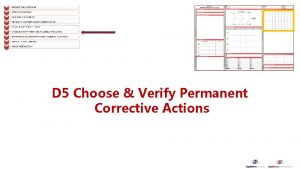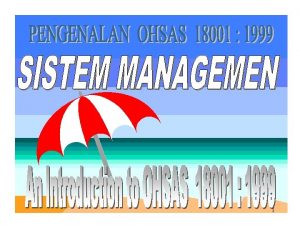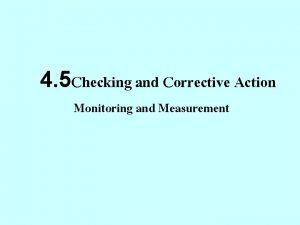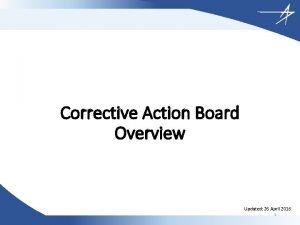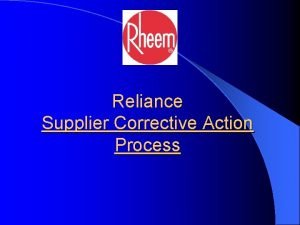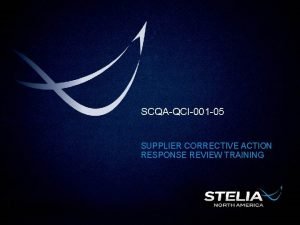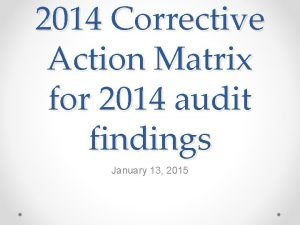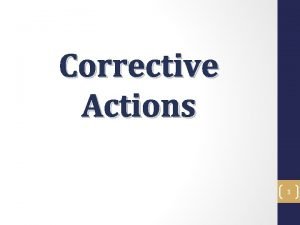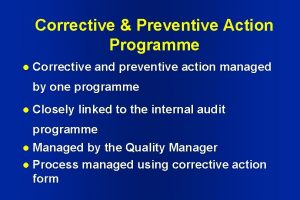ASQ Memphis Origin of 8 Discipline Corrective Action









- Slides: 9

ASQ Memphis Origin of 8 Discipline Corrective Action April 15, 2014 Product Market Sector: Air Conditioning Prepared by: M. Nick Mahintorabi Date: Jun 7, 2013

8 -D: Background / History and Ford Motor Company 8 D methodology despite what is generally thought has not been created by Ford but by the U. S. Department of Defense (DOD) in 1974. The standard, which described 8 D, was named: “MIL-STD 1520 Corrective Action and Disposition System for Nonconforming Material” Standard was officially abolished in 1995, but the 8 D methodology has been propagated by Ford in the automotive industry and is well known to many companies in the electronics industry. Ford Automotive Application The executives of the Powertrain Organization (transmissions, chassis, engines) wanted a methodology where teams (design engineering, manufacturing engineering, and production) could work on recurring problems. 1986, the assignment was given to develop a manual and a subsequent course that would achieve a new approach to solving tough engineering design and manufacturing problems. The manual for this methodology was documented and defined in Team Oriented Problem Solving (TOPS), first published in 1987. The manual and subsequent course material were piloted at Ford world headquarters in Dearborn, Michigan. Product Market Sector: Air Conditioning 2 / Continental AG

8 -D: Background / History and Ford Motor Company Many changes and revisions were made based on feedback from the pilot sessions. This has been Ford's approach to problem solving ever since. It was never based on any military standard or other existing problem solving methodology. Ford refers to their current variant as G 8 D (Global 8 D). Military Usage The US Government first standardized a process during the Second World War as Military Standard 1520, Corrective Action and Disposition System for Nonconforming Material. This military standard focused on nonconforming material and the disposition of the material. Common Usage Many disciplines are typically involved in the "8 D" process, all of which can be found in textbooks and reference materials used by quality assurance professionals. Product Market Sector: Air Conditioning 3 / Autor / Druckdatum © Continental AG

8 -D: Background / History Continued For example, an "Is/Is Not" worksheet is a common tool employed at D 2, and Ishikawa, or "fishbone, " diagrams and "5 why analysis" are common tools employed at step D 4. In the late 1990 s, Ford developed a revised version of the 8 D process that they call "Global 8 D" (G 8 D) which is the current global standard for Ford and many other companies in the automotive supply chain. The major revisions to the process are as follows: Addition of a D 0 (D-Zero) step as a gateway to the process. At D 0, the team documents the symptoms that initiated the effort along with any emergency response actions (ERAs) that were taken before formal initiation of the G 8 D. D 0 also incorporates standard assessing questions meant to determine whether a full G 8 D is required. The assessing questions are meant to ensure that in a world of limited problem-solving resources, the efforts required for a full team-based problem-solving effort are limited to those problems that warrant these resources. Product Market Sector: Air Conditioning 4 / Autor / Druckdatum © Continental AG

FMEA: Background / History Continued Addition of the notion of escape points to D 4 through D 6. An 'escape point' is the earliest control point in the control system following the root cause of a problem that should have detected that problem but failed to do so. The idea here is to consider not only the root cause, but also what went wrong with the control system in allowing this problem to escape. Global 8 D requires the team to identify and verify an escape point at D 4. Then, through D 5 and D 6, the process requires the team to choose, verify, implement, and validate permanent corrective actions to address the escape point. Recently, the 8 D process has been employed significantly outside the auto industry. As part of lean initiatives and continuous-improvement processes it is employed extensively in the food manufacturing, health care, and high-tech industries. Advantages Effective approach at finding a root cause, developing proper actions to eliminate root causes, and implementing the permanent corrective action. Also helps to explore the control system that allowed the problem to escape. The Escape Point is studied for the purpose of improving the ability of the Control System to detect the failure or cause when and if it should occur again. Finally the Prevention Loop explores the systems that permitted the condition that allowed the Failure and Cause Mechanism to exist in the first place. Product Market Sector: Air Conditioning 5 / Continental AG

FMEA: Logic and Description Disadvantages Requires training in the 8 D problem-solving process as well as appropriate data collection and analysis tools such as: Pareto diagrams, Fishbone Diagrams, and flowcharts. Product Market Sector: Air Conditioning 6 / Autor / Druckdatum © Continental AG

8 -D: Definition and Description Eight Disciplines Problem Solving (8 D) is a method used to approach and to resolve problems, typically employed by quality engineers or other professionals. Its purpose is to identify, correct and eliminate recurring problems, and it is useful in product and process improvement. It establishes a permanent corrective action based on statistical analysis of the problem (when appropriate) and focuses on the origin of the problem by determining its root causes. Although it originally comprised eight stages, or 'disciplines', it was later augmented by an initial planning stage. Product Market Sector: Air Conditioning 7 / Autor / Druckdatum © Continental AG

8 -D: Definition and Description The 8 D follows the logic of the PDCA cycle. The disciplines are: D 0: Plan for solving the problem and determine the prerequisites. D 1: Use a Team: Establish a team of people with product/process knowledge. D 2: Define and describe the Problem: Specify the problem by identifying in quantifiable terms the who, what, where, when, why, how, and how many (5 W 2 H) for the problem. D 3: Develop Interim Containment Plan; Implement and verify Interim Actions: Define and implement containment actions to isolate the problem from any customer. D 4: Determine, Identify, and Verify Root Causes and Escape Points: Identify all applicable causes that could explain why the problem has occurred. Also identify why the problem has not been noticed at the time it occurred. All causes shall be verified or proved, not determined by fuzzy brainstorming. One can use five whys or Ishikawa diagrams to map causes against the effect or problem identified. Product Market Sector: Air Conditioning 8 / Autor / Druckdatum © Continental AG

8 -D: Definition and Description Continued D 5: Choose and Verify Permanent Corrections (PCs) for Problem/Non Conformity: Through pre-production programs quantitatively confirm that the selected correction will resolve the problem for the customer. (Verify the correction will actually solve the problem) D 6: Implement and Validate Corrective Actions: Define and Implement the best corrective actions. D 7: Take Preventive Measures: Modify the management systems, operation systems, practices, and procedures to prevent recurrence of this and all similar problems. D 8: Congratulate Your Team: Recognize the collective efforts of the team. The team needs to be formally thanked by the organization. Product Market Sector: Air Conditioning 9 / Continental AG



